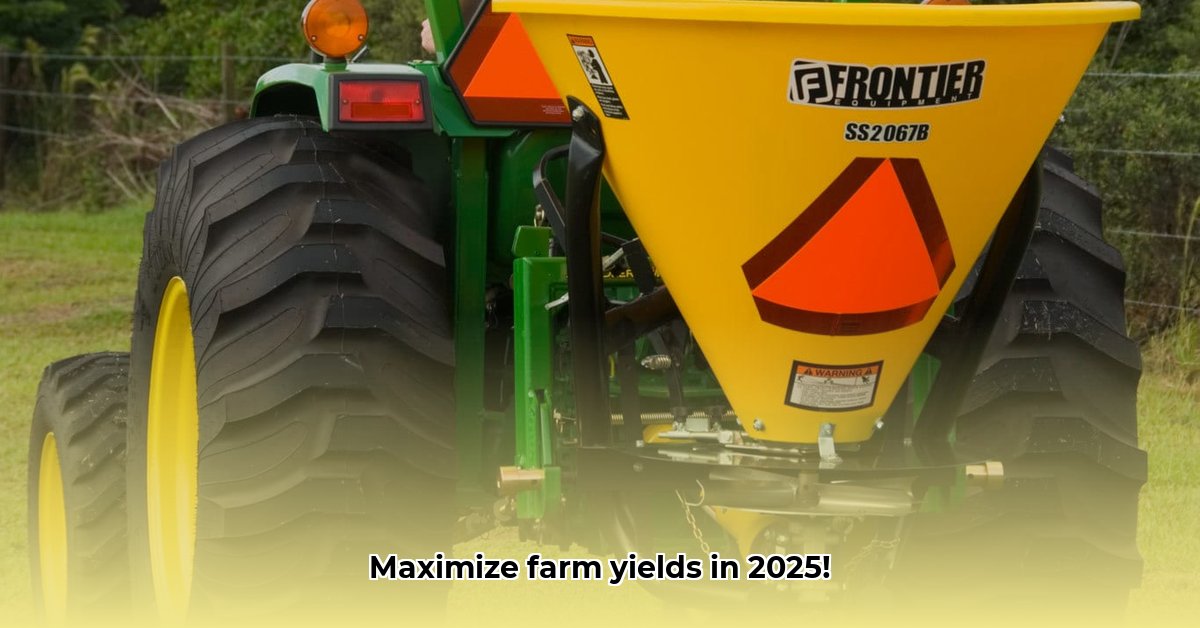
Choosing the Right Seeder for Your Farm
Tired of inefficient seeding methods and wasted resources? Investing in the right tow-behind seeder can significantly boost your farm's efficiency and sustainability. This comprehensive guide helps you navigate the selection process, ensuring you choose a seeder perfectly matched to your needs and farming practices. Did you know that precision seeding can reduce seed waste by up to 30%? For efficient soil preparation, consider a rotary tiller.
Key Factors in Seeder Selection
Selecting the ideal seeder involves considering several crucial factors:
Land Size: The size of your farm directly influences the required seeder capacity. Small plots may only need a compact, manually operated seeder, while large farms require high-capacity models capable of covering extensive areas efficiently. A larger hopper means fewer refills, saving valuable time.
Crop Type: Different crops have unique seeding requirements. Smaller seeds like lettuce necessitate precision seeders for optimal spacing, while larger seeds such as corn might be successfully planted with a broadcast seeder. Consider seed size, required spacing, and planting depth when making your choice.
Soil Type: Soil conditions significantly impact seeder performance. Heavy clay soils may require a more robust seeder with greater penetrating power than lighter sandy soils. Understanding your soil type helps you select a seeder that ensures proper seed placement and germination.
Budget: Seeders range in price from a few hundred dollars to several thousand. Determine your budget upfront to narrow down your options while considering long-term costs, including maintenance and repairs. A durable seeder, even if more expensive initially, could save you money in the long run.
Essential Features: Key features to consider include adjustable seeding rates (for precise control over planting density), adjustable row spacing (for optimal crop spacing and yield), and hopper size (for minimizing refilling frequency). Additional features like GPS guidance systems can further enhance precision and efficiency.
Types of Seeders: Broadcast vs. Row
Two primary seeder types cater to diverse farming needs:
Broadcast Seeders: These spread seeds over a wide area, ideal for cover crops or smaller seeds where precise spacing isn't critical. They are generally less expensive and easier to maintain.
Row Seeders: These plant seeds in precise rows, ensuring consistent spacing and depth, suitable for crops like corn, soybeans, or vegetables requiring specific planting patterns. They typically offer greater control and precision but come with a higher price tag.
"Choosing between broadcast and row seeders depends heavily on the crops you're growing and your farm's scale," explains Dr. Emily Carter, Agricultural Engineer at Purdue University. "Broadcast seeders are cost-effective for cover crops, while row seeders excel at ensuring optimal spacing for high-yield crops."
Using Your Tow-Behind Seeder: A Step-by-Step Guide
Preparation
- Land Preparation: Prepare the field before seeding. This may involve tilling, disking, or other soil preparation methods to create a suitable seedbed.
- Seeder Calibration: Calibrate your seeder according to the manufacturer's instructions. This ensures accurate seeding rates and consistent seed spacing. Accurate calibration is crucial for maximizing yield and minimizing waste.
Seeding Process
- Attachment: Securely attach the seeder to your tractor or ATV.
- Seeding Operation: Maintain a consistent speed during seeding to ensure uniform seed distribution and depth. Observe the seeder's performance closely; adjust settings as needed to maintain consistent seed placement.
- Monitoring: Regularly monitor the seeding process for any issues, such as clogging or uneven seed distribution. Promptly address any problems to maintain seeding efficiency.
Post-Seeding Maintenance
- Cleaning: Thoroughly clean the seeder after each use to remove seeds, soil, and debris, preventing clogging and corrosion.
- Lubrication: Lubricate moving parts according to the manufacturer's recommendations. Regular lubrication minimizes wear and tear, extending the seeder's lifespan.
- Storage: Store the seeder in a dry, protected environment to prevent damage from weather elements.
Sustainable Farming Practices with Your Seeder
Employing a seeder directly contributes to sustainable agricultural practices:
- Precision Seeding: Reduces seed waste, minimizing environmental impact and lowering costs.
- No-Till Farming: If applicable to your seeder, no-till farming reduces soil disturbance, improving soil health and reducing erosion.
- Cover Cropping: Seeders allow for efficient planting of cover crops, enhancing soil fertility and suppressing weeds. Cover cropping helps improve soil structure, leading to better water retention.
"Sustainable farming is about maximizing efficiency and minimizing environmental footprints," says John Miller, a leading sustainable agriculture expert. "Your seeder plays a crucial role in achieving this."
Troubleshooting Common Seeder Problems
- Uneven Seed Distribution: Check for clogs in the seed tubes or hopper. Recalibrate the seeder if necessary. Ensure consistent tractor speed and maintain proper seed depth.
- Inconsistent Seed Depth: Adjust the depth settings according to your soil type and seed requirements. Ensure the ground is properly prepared before you begin seeding.
- Mechanical Issues: Consult your seeder's manual for troubleshooting advice or contact a qualified technician for repairs.
Conclusion: Maximize Your Harvest
Investing in a suitable tow-behind seeder is a crucial step towards enhancing farming efficiency and adopting sustainable practices. By following this guide's recommendations, you'll be well-equipped to choose the right seeder, optimize its use, and contribute to a more productive and environmentally conscious agricultural operation. Remember, regular maintenance is crucial for longevity and optimal performance.